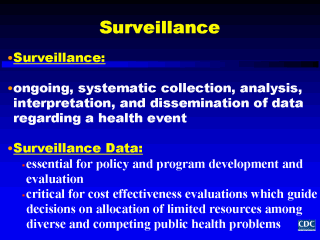| front |1 |2 |3 |4 |5 |6 |7 |8 |9 |10 |11 |12 |13 |14 |15 |16 |17 |review |
 |
First, letís review what surveillance is. When evaluating public health surveillance systems, public health surveillance is defined as "...the ongoing, systematic collection, analysis, interpretation, and dissemination of data regarding a health-related event for use in public health action to reduce morbidity and mortality and to improve health (1-4). Traditionally epidemiological surveillance was focused on infectious diseases. However, over time, surveillance within the field of public health has expanded to also encompass concern with non-infectious conditions such chronic diseases, injuries, and environmental and occupational exposures, as well as personal behaviors that promote health and prevent disease. Surveillance data from all of these areas is essential for developing policies and programs and evaluating their effectiveness in preventing and efficiently bringing public health problems under control. When personnel and financial resources are limited, surveillance data is also critical for cost effectiveness evaluations which guide decisions on how limited resources can be prioritized and allocated to resolve a multitude of diverse and competing public health problems simultaneously. 1) Thacker SB. Historical development. IN: Teutsch SM, Churchill RE, Eds. Principles and practice of public health surveillance, 2nd ed. New York, NY: Oxford University Press, 2000.2) Buehler JR. Surveillance. In: Rothman KJ, Greenland S. Modern epidemiology, 2nd ed. Philadelphia, pA: Lippencott-Raven, 1998. 3) Teutsch SM. Thacker SB. Planning a public health surveillance system. Epidemiological Bulletin: Pan American Health Organization 1995; 16: 1-6. 4) Centers for Disease Control. Updatead guidelines for evaluating public health surveillance systems. Recommendations from the Guidelines Working Group. MMWR 2001; 50 (RR13): 2. |
| front |1 |2 |3 |4 |5 |6 |7 |8 |9 |10 |11 |12 |13 |14 |15 |16 |17 |review |